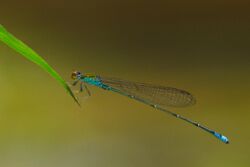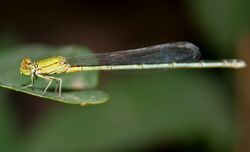Biology:Pseudagrion rubriceps
| Saffron-faced blue dart | |
|---|---|

| |
| Male | |

| |
| Female | |
| Scientific classification | |
| Domain: | Eukaryota |
| Kingdom: | Animalia |
| Phylum: | Arthropoda |
| Class: | Insecta |
| Order: | Odonata |
| Suborder: | Zygoptera |
| Family: | Coenagrionidae |
| Genus: | Pseudagrion |
| Species: | P. rubriceps
|
| Binomial name | |
| Pseudagrion rubriceps Selys, 1876
| |
| Synonyms | |
| |
Pseudagrion rubriceps,[2][1] saffron-faced blue dart,[3][4] is a species of damselfly in the family Coenagrionidae. It is found in many tropical Asian countries.[1][5]
Description and habitat
It is a medium sized damselfly with bright orange eyes, greenish below. The male is easily distinguished from all other Pseudagrion species by the brilliant reddish-orange face, from which it derives its common name. Its thorax is olive green above and azure blue on the sides. There is a narrow mid-dorsal carina and humeral stripes in black. Abdomen is blue on the sides, broadly marked with black on dorsum, up to segment 8. Segments 9 and 10 are azure blue without any marks. Anal appendages are black.[6]
Eyes, face and thorax of the female is yellowish green, marked as in the male. Color of the abdomen is similar to the male; but paler. Segments 8 and 9 are also black with fine apical blue rings. Segment 10 is pale blue.[6]
Widely distributed throughout the plains and submontane areas. It breeds in weedy streams and ponds.[6][7][8][3][4]
Subspecies
Two subspecies recognized.[9]
- Pseudagrion rubriceps ceylonicum - Endemic to Sri Lanka
- Pseudagrion rubriceps rubriceps - Other Asian countries.[10]
See also
- List of odonates of India
- List of odonates of Sri Lanka
- List of odonata of Kerala
References
- ↑ 1.0 1.1 1.2 Pal, M. (2011). "Pseudagrion rubriceps". IUCN Red List of Threatened Species 2011: e.T167385A6339532. doi:10.2305/IUCN.UK.2011-1.RLTS.T167385A6339532.en. https://www.iucnredlist.org/species/167385/6339532. Retrieved 20 November 2021.
- ↑ "World Odonata List". University of Puget Sound. https://www.pugetsound.edu/academics/academic-resources/slater-museum/biodiversity-resources/dragonflies/world-odonata-list2/.
- ↑ 3.0 3.1 "Pseudagrion rubriceps Selys, 1876". India Biodiversity Portal. http://indiabiodiversity.org/species/show/228182.
- ↑ 4.0 4.1 "Pseudagrion rubriceps Selys, 1876". Odonata of India, v. 1.00. Indian Foundation for Butterflies. http://www.indianodonata.org/sp/397/Pseudagrion-rubriceps.
- ↑ K.A., Subramanian; K.G., Emiliyamma; R., Babu; C., Radhakrishnan; S.S., Talmale (2018). Atlas of Odonata (Insecta) of the Western Ghats, India. Zoological Survey of India. pp. 179–180. ISBN 9788181714954.
- ↑ 6.0 6.1 6.2 C FC Lt. Fraser (1933). The Fauna of British India, including Ceylon and Burma, Odonata Vol. I. Red Lion Court, Fleet Street, London: Taylor and Francis. pp. 296–299. https://archive.org/details/FraserOdonata1.
- ↑ C FC Lt. Fraser (1924). A Survey of the Odonate (Dragonfly) Fauna of Western India and Descriptions of Thirty New Species. pp. 497. http://faunaofindia.nic.in/PDFVolumes/records/026/05/0423-0522.pdf.
- ↑ Subramanian, K. A. (2005). Dragonflies and Damselflies of Peninsular India - A Field Guide. http://www.ias.ac.in/Publications/Overview/Dragonflies.
- ↑ "Archived copy". http://lkcnhm.nus.edu.sg/nis/bulletin2009/2009nis209-214.pdf.
- ↑ "Pseudagrion rubriceps Selys, 1876". https://www.gbif.org/species/1422910.
External links
Wikidata ☰ Q1864329 entry
 |


